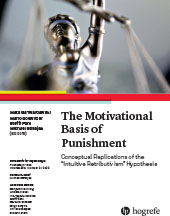What Motivates Direct and Indirect Punishment?
Extending the “Intuitive Retributivism” Hypothesis
Abstract
Abstract. Punishment represents a key mechanism to deter norm violations and is motivated by retribution and/or general deterrence. Retribution-motivated punishment is tailored to offense severity, whereas deterrence-motivated punishment is tailored to different factors, including punishment observability. This study aimed to replicate and extend prior work by testing how offense severity and punishment observability motivate direct, confrontational punishment versus indirect, covert punishment. Participants (N = 308) read vignettes describing offenses with varying severity (high vs. low) and punishment observability (high vs. low). We then assessed their punishment tendencies – overall, direct, and indirect – and their endorsement of retribution and deterrence motives. Findings supported a “strong version” of intuitive retributivism. Manipulating retribution-relevant information consistently influenced punishment: participants reported stronger overall, direct, and indirect punishment tendencies when severity was high (vs. low). Self-reported deterrence (but not retribution) motives positively related to overall, direct, and indirect punishment tendencies. However, manipulating deterrence-relevant information did not influence punishment.
References
(2004). Sex differences in aggression in real-world settings: A meta-analytic review. Review of General Psychology, 8(4), 291–322. https://doi.org/10.1037/1089-2680.8.4.291
(2005). An integrated review of indirect, relational, and social aggression. Personality and Social Psychology Review, 9(3), 212–230. https://doi.org/10.1207/s15327957pspr0903_2
(2014). Direct and indirect punishment among strangers in the field. Proceedings of the National Academy of Sciences, 111(45), 15924–15927. https://doi.org/10.1073/pnas.1413170111
(2016). Altruistic punishment does not increase with the severity of norm violations in the field. Nature Communications, 7(1), 1–6. https://doi.org/10.1038/ncomms13327
(2011). Reward, punishment, and cooperation: A meta-analysis. Psychological Bulletin, 137(4), 594–615. https://doi.org/10.1037/a0023489
(2006). Reputational benefits for altruistic punishment. Evolution and Human Behavior, 27(5), 325–344. https://doi.org/10.1016/j.evolhumbehav.2006.01.003
(2010). Has punishment played a role in the evolution of cooperation? A critical review. Mind & Society, 9(2), 171–192. https://doi.org/10.1007/s11299-010-0079-9
(2013). Interventions against norm violations: Dispositional determinants of self-reported and real moral courage. Personality and Social Psychology Bulletin, 39(8), 1053–1068. https://doi.org/10.1177/0146167213490032
(2011). How the grapevine keeps you in line: Gossip increases contributions to the group. Social Psychological and Personality Science, 2(6), 642–649. https://doi.org/10.1177/1948550611405073
(1993). Egalitarian behavior and reverse dominance hierarchy. Current Anthropology, 34(3), 227–254. https://doi.org/10.1086/204166
(1992). Punishment allows the evolution of cooperation (or anything else) in sizable groups. Ethology and Sociobiology, 13(3), 171–195. https://doi.org/10.1016/0162-3095(92)90032-Y
(1999). Staying alive: Evolution, culture, and women’s intrasexual aggression. Behavioral and Brain Sciences, 22(2), 203–214. https://doi.org/10.1017/S0140525X99001818
(2006). The roles of retribution and utility in determining punishment. Journal of Experimental Social Psychology, 42(4), 437–451. https://doi.org/10.1016/j.jesp.2005.06.007
(2002). Why do we punish? Deterrence and just deserts as motives for punishment. Journal of Personality and Social Psychology, 83(2), 284–299. https://doi.org/10.1037/0022-3514.83.2.284
(2014). The value of vengeance and the demand for deterrence. Journal of Experimental Psychology: General, 143(6), 2279–2286. https://doi.org/10.1037/xge0000018
(2009). Mysteries of morality. Cognition, 112(2), 281–299. https://doi.org/10.1016/j.cognition.2009.05.008
(2013). A solution to the mysteries of morality. Psychological Bulletin, 139(2), 477–496. https://doi.org/10.1037/a0029065
(2020). An integrative definition and framework to study gossip. PsyArXiv. https://doi.org/10.31234/osf.io/b8x57
(2020). Moral emotions and aggressive tactics in third-party punishment: The effect of welfare tradeoff ratio. Manuscript in preparation.
(2003). The nature of human altruism. Nature, 425(6960), 785–791. https://doi.org/10.1038/nature02043
(2002). Altruistic punishment in humans. Nature, 415(6868), 137–140. https://doi.org/10.1038/415137a
(2014). Gossip and ostracism promote cooperation in groups. Psychological Science, 25(3), 656–664. https://doi.org/10.1177/0956797613510184
(2004). Research on gossip: Taxonomy, methods, and future directions. Review of General Psychology, 8(2), 78–99. https://doi.org/10.1037/1089-2680.8.2.78
(2008). Strong reciprocity and the roots of human morality. Social Justice Research, 21(2), 241–253. https://doi.org/10.1007/s11211-008-0067-y
(1998). The emerging field of emotion regulation: An integrative review. Review of General Psychology, 2(3), 271–299. https://doi.org/10.1037/1089-2680.2.3.271
(2003). Individual differences in two emotion regulation processes: Implications for affect, relationships, and wellbeing. Journal of Personality and Social Psychology, 85(2), 348–362. https://doi.org/10.1037/0022-3514.85.2.348
(2012). Reciprocity: Weak or strong? What punishment experiments do (and do not) demonstrate. Behavioral and Brain Sciences, 35(1), 1–15. https://doi.org/10.1017/S0140525X11000069
(2006). Costly punishment across human societies. Science, 312(5781), 1767–1770. https://doi.org/10.1126/science.1127333
(2018). Moral punishment in everyday life. Personality and Social Psychology Bulletin, 44(12), 1697–1711. https://doi.org/10.1177/0146167218775075
(2014). Morality in everyday life. Science, 345(6202), 1340–1343. https://doi.org/10.1126/science.1251560
(2019). Signaling when no one is watching: A reputation heuristics account of outrage and punishment in one-shot anonymous interactions. Journal of Personality and Social Psychology, 118(1), 57–88. https://doi.org/10.1037/pspi0000186
(2012). What are punishment and reputation for? PLoS One, 7(9), Article e45662. https://doi.org/10.1371/journal.pone.0045662
(2016). Looking under the hood of third-party punishment reveals design for personal benefit. Psychological Science, 27(3), 405–418. https://doi.org/10.1177/0956797615624469
(2007). Audience effects on moralistic punishment. Evolution and Human Behavior, 28(2), 75–84. https://doi.org/10.1016/j.evolhumbehav.2006.06.001
(2019). Too fast, too straight, too weird: Non-reactive indicators for meaningless data in internet surveys. Survey Research Methods, 13(3), 229–248.
(2008). Revenge, retribution, and values: social attitudes and punitive sentencing. Social Justice Research, 21(2), 138–163. https://doi.org/10.1007/s11211-008-0066-z
(2017). Disgust and anger relate to different aggressive responses to moral violations. Psychological Science, 28(5), 609–619. https://doi.org/10.1177/0956797617692000
(2020). Direct and indirect punishment of norm violations in daily life. Nature Communications, 11, Article 3432. https://doi.org/10.1038/s41467-020-17286-2
(2021). Direct punishment and indirect reputation-based tactics to intervene against offences. Philosophical Transactions of the Royal Society B, 376(1838), Article 20200289. https://doi.org/10.1098/rstb.2020.0289
(2008). Punishment and counter-punishment in public good games: Can we really govern ourselves? Journal of Public Economics, 92(1), 91–112. https://doi.org/10.1016/j.jpubeco.2007.04.008
(2019). When and why do third parties punish outside of the lab? A cross-cultural recall study. Social Psychological and Personality Science, 11(6), 846–853. https://doi.org/10.1177/1948550619884565
(2015). The reputation of punishers. Trends in Ecology & Evolution, 30(2), 98–103. https://doi.org/10.1016/j.tree.2014.12.003
(2019). Punishment: One tool, many uses. Evolutionary Human Sciences, 1, Article e12. https://doi.org/10.1017/ehs.2019.12
(2009). Formidability and the logic of human anger. Proceedings of the National Academy of Sciences, 106(35), 15073–15078. https://doi.org/10.1073/pnas.0904312106
(2020). Punishment goals in classroom interventions: An attributional approach. Journal of Experimental Psychology: Applied, 26(1), 61–72. https://doi.org/10.1037/xap0000223
(2020). Is it all about retribution? The flexibility of punishment goals. Social Justice Research, 33, 195–218. https://doi.org/10.1007/s11211-020-00352-x
(2020). Disgust, anger, and aggression: Further tests of the equivalence of moral emotions. Collabra: Psychology, 6, 34. https://doi.org/10.1525/collabra.349
(2016). Gossip versus punishment: The efficiency of reputation to promote and maintain cooperation. Scientific Reports, 6(1), 1–8. https://doi.org/10.1038/srep23919



